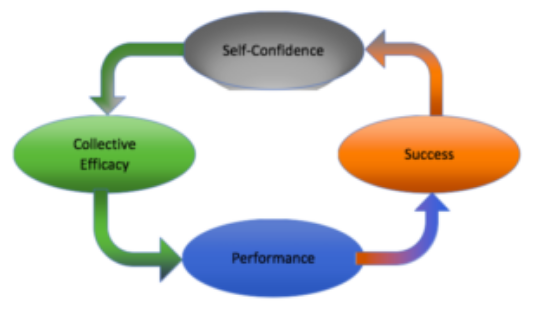2.3 – Team Communication in the Workplace

We enter the workplace as individuals and then quickly interact with peers, work groups, and customer groups. As we make our way through our careers, we see that work is best accomplished with the power of others. Learning effective group and team communication skills advances your success and the success of your organization.
Developing a group or team is a useful approach to accomplishing a task. During this discussion, the terms “group” and “team” are used interchangeably. When developed and run effectively, a team can be used to pool the ideas and experiences of its members in search of a collective outcome. Organizations of all types can benefit from the work of teams. An effective team should be able to share experiences and provide members with feedback. By sharing experiences, teams can generate insight and become effective problem solvers through a collaborative effort. Developing a successful team requires understanding group dynamics and how to adapt to the strengths and quirks of team members.
This module provides skills related to workplace communication in these valuable groups and teams. It examines the types of teams, the roles of team members, and how to communicate within teams. There are other group interactions that deserve special attention in business communication as well.
LEARNING OBJECTIVES
- Discuss the value of teams in business communication
- Discuss types of teams in organizations
- Explain the advantages and disadvantages of teams and team dynamics
- Discuss the impact of group size on communication
- Describe various ways of interpreting and responding to conflict in interpersonal communication
The Value of Teams in Business Communication
You hear a lot about teams every day—sports teams, disaster and rescue teams, and medical support teams. Teams exist because they are effective in achieving goals, especially when the goal is well-defined. In the business environment, reliance on teams has been growing in the last few decades as organizations become more virtual (operating over distance) and more structurally complex. Businesses rely on teams to perform tasks not well suited to more traditional organizational structures. The most common types of teams are discussed in this section.
Business organizations have both groups and teams. A group is formed around a common interest or purpose with the goal of sharing information, but there is no collective accountability. Employee groups may consist of social clubs or volunteer efforts. A team’s focus is collective performance, with both individual and mutual accountability. For example, all of the people who work in accounting constitute a group, but people from each functional department who meet regularly to standardize financial procedures are a team.
Teams bring together members of the organization with a wide variety of skills to achieve a common goal. Organizations accomplish these goals by carefully selecting the type of teams they use.
Types of Teams

The team is only as good as its members and the ways in which they interact with each other. How many members should be on a team is largely dependent on the reason the team was established. According to “Sharpening the Team Mind”1, when deciding on the number of members to have on a team, consider the “uneven communication problem.” This theory states that only a handful of team members do all the talking. For example, in a team of six, three people do 86% of all the talking.
Here are several types of teams that may be used in the workplace. As you read through them, consider their purpose and the likely communication issues.
Cross-Functional Teams

A cross-functional team is just what it sounds like—a team that pulls its members from across the different functional areas of an organization. These teams are typically permanent or long-standing. For example, cross-functional teams may be composed of representatives from production, sales, marketing, finance, and legal. The strength of this type of team lies in its members having different functional backgrounds, education, and experience. The diversity of experience contributes to innovative problem-solving and decision-making.
Cross-functional teams may be used to implement new solutions in the workplace. A simple example is when a group of instructors used grant money to purchase PCs for all four of their classrooms. Without a cross-functional team, the teachers might have overlooked the special electrical considerations of rack-mounted charging stations for the 25 PCs. The campus engineers are needed. Without a cross-functional team, the teachers might have overlooked the special campus security software. Inviting other departments leads to greater project success by using expertise from many areas.
Unfortunately, the very factors that give cross-functional teams strength can also lead to weaknesses. Without a strong leader and very specific goals, it may be hard to foster social cohesion in cross-functional teams and create a system of accountability. A cross-functional team might be brought together to review and make recommendations on potential acquisitions or mergers.
Task Forces

A task force is a group or committee, usually of experts or specialists, formed for analyzing, investigating, or solving a specific problem. Quite often, a task force is formed in reaction to a problem or specific event, and once the job is done, the task force is disbanded. The goal of a task force is to offer solutions, support, and if possible, put preventive measures in place against future problems.
A task force might be used to assess the causes for declining customer traffic at a store location, for example. There might be team members from marketing who analyze competitors in the areas and changes in customer preference. There might be operational members who review internal procedures related to stock management and customer interactions.
Types of concerns that may generate task forces in the workplace include bullying, health and wellness, employee training, increasing customer sales, or improving employee job satisfaction. A project team is similar to a task force, but a project team is often ongoing and covers a wider range of tasks.
Virtual Teams

Virtual teams are groups of individuals digitally working together with a common purpose but in different locations. Virtual teams by definition may overlap with the team types listed above. People may be in different time zones or even different organizations. The obvious advantage of a virtual team is the low cost, both in time and money, to maintain it. Meeting in a virtual space increases flexibility for team members (people can attend from wherever they are) and allows the organization to use the talent of employees around the globe.
The idea of virtual teams is relatively new; however, according to IQVIS an information management consulting firm, the use of virtual teams has grown 80 percent from 2005 to 2015. Virtual teams are possible thanks to advances in communication technology, such as e-mail, the Internet, videoconferencing, collaboration platforms, and other products.
When considering virtual teams, remember that working across cultures can be as challenging as working cross-functionally. Working with team members from different cultures means working with potentially different leadership styles and decision-making processes. In the United States, managers tend to gather data, make quick decisions, and move forward, making corrections as needed. Northern Europeans prefer to build consensus slowly, whereas French schoolchildren are trained to debate and confront. Some business consultants will tell you that decisions in Japan are made in small, informal conversations before the formal meeting ever takes place. All teams need to be sensitive to these issues, which may be far more prevalent among the members of virtual teams.
In spite of these barriers, many companies have been adopting virtual teams. SAP is the world’s largest inter-enterprise software company with more than 30,000 employees in sixty countries. It relies on virtual teams to survive. It has five headquarters around the globe, each one with a specific area of expertise shared via virtual meetings. IBM and General Electric are corporations that also depend on virtual team strategies.
Self-Managed Teams

A self-managed team is a group of employees that is responsible and accountable for all or most aspects of generating a product or delivering a service. It could be thought of as a mini-company within a larger organization. Traditional organizations assign tasks to employees depending on their skills or functional departments (sales, finance, production). A self-managed team carries out the supporting tasks as well, such as planning and scheduling the technical workflow, and human-resource tasks such as managing vacations and absences. Team members may take turns leading and assuming technical responsibilities.
An example of a self-managed team is a remote group of engineers that double-checks and configures technical sales data that is uploaded daily. Rather than wait for a supervisor to assign tasks to the group, the group manages job assignments based on availability and skills. The group then works with project managers to implement solutions, again based on the team rather than a supervisor’s decision. The work finishes with the billing team. When difficulties or disagreements are encountered, the team works it out for themselves.
Because of the autonomy given to self-managed teams, these teams have greater ownership of the jobs they perform. Some benefits of self-managed teams are that team members share accountability for what they accomplish, which can be a great motivator; individuals have a greater commitment to the task because they’re directly responsible for its results, and team members take on some of their manager’s work so he or she can work on other tasks.
However, self-managed teams are not without problems. Groupthink occurs more frequently with these teams. Members may struggle during the transition from supervisor-led management to self-management, possibly because of a lack of interpersonal skills or poor implementation by the company. Not surprisingly, the most effective self-managing teams are found in companies where the corporate culture supports democratic decision-making, and the employees are generally well-educated.
No matter how groups and teams come together, there are advantages and disadvantages that must be attended to, as in the unintentional assumption of roles by gender or age rather than by experience or expertise.
Teams and Team Dynamics
People are social animals and function best when they work with others in groups or teams. Some human behaviors show up repeatedly among groups. In the workplace, it is important to understand how these behaviors affect performance. Being aware of the advantages and disadvantages of teams in the workplace helps workers bring out the best while overcoming their weaknesses. Mindfully and deliberately assigning specific roles to team members strengthens a team.
Teams are common in larger organizations, and they benefit both the company and the employees. People who feel they are part of a team are often mutually supportive and report greater job satisfaction. However, not all teams are successful. In one survey, only 14 percent of the companies rated their teams as highly effective,2 around 50 percent rated them as somewhat effective, and 15 percent rated them as not effective at all. In this module, we look at teams and how effective teams are developed. We start by looking at common behaviors that can help or hurt efforts to meet organizational goals.
Advantages
Teams bring together people with diverse skills to create something that no one person could do alone. A well-planned team improves motivation. Communication is higher in teams, and the diverse skill set means teams can discover new approaches. Because teams have specific shared goals, team members usually enjoy greater autonomy, variety, task identity, task significance, and feedback. Teams often enjoy social support for difficult tasks, improving morale and motivation.
Another benefit of teams is to improve product and service quality. Each Whole Foods grocery store operates with an average of ten “self-managed” teams, including produce, prepared foods, groceries, etc. Each store also has a team made up of just the leaders from each team to facilitate communication and sharing. Each team takes responsibility for the quality of the products and services in its area.
Efficiency in product development is another advantage of building teams within the traditional hierarchy. Teams can analyze and identify dependent tasks in a nonlinear process, sometimes realizing startling improvements.
Employees also benefit from participating in teams. They develop relationships with people from other areas of the business and learn more about what is happening across functional department lines (cross-training). A 2009 study by CG and WHU-Otto Beisheim School of Management among eighty global software development teams showed that members of effective teams are more motivated and report greater job satisfaction, which leads to fewer employees quitting.
According to LaFasto and Larson in “When Teams Work Best,”3 there are four aspects of a good relationship: constructive, productive, mutual understanding, and self-corrective. These four aspects are the basis for LaFasto and Larson’s Connect model (Table 1), which can be used to develop good relationships.
A constructive relationship can also be between a person and the team. “Good relationships are constructive for both people.”4 In order to have a constructive relationship, there must be trust and mutual understanding between both parties. Constructive relationships do not happen overnight, it takes time to develop trust and to be open with others. Productive relationships are important because if the relationship between two individuals on a team is not productive, the team may not be productive. Productive relationships also, “allow us to focus on real issues—the ones that matter—and to do so in a way that makes a difference.”5 Mutual understanding is critical because, “[it encourages] us to focus on and understand the other person’s perspective, and [it offers] us the satisfaction of being understood.”6 Not only is it important to validate another person’s point of view, but it is also important for us to be validated. It goes back to trust and building a constructive relationship; in order to be understood, you have to be able to understand others. Good relationships are self-corrective, like a good marriage in which each partner is committed to improving the relationship. By continuing to work on improving a relationship, you are developing trust and mutual understanding among the parties.

Social cohesion is defined as the willingness of members of a society to cooperate with each other to survive and prosper. In work teams, social cohesiveness means the members want to be part of the team and want to contribute to its success. Members of cohesive teams have social and emotional bonds to each other and to the overall team, which motivates higher commitment and performance. Southwest Airlines, for instance, works hard to develop cohesiveness in its organization. As a result, everyone is willing to work toward the success of the organization. That is why it is not unusual to see people pitch in on a task even when it is not part of their job. For example, pilots may help to load luggage if it helps maintain on-time performance.
The main factors influencing cohesion are the size of the group, similarities among its members, and team success. Small groups tend to be more cohesive than larger ones because people can interact with each other more. Similarity among group members contributes to team cohesiveness because people with similar backgrounds are more likely to have fewer communication barriers and share views on what constitutes appropriate behaviors. People are generally more trusting of others when they share some important background experiences. In substance abuse recovery groups, for example, members know that everyone has had the same ailment and is dealing with similar experiences. When a team experiences success early in its development, members get reinforcement that their efforts can produce results. They are more likely to be motivated to continue to contribute. Success also creates a sense of pride that fosters feelings of belonging and mutual attraction in the team.

Collective efficacy is the team’s belief that its members are capable of organizing and working together to reach its goals. Creating collective efficacy is a bit of a balancing act. If goals are perceived as being too easy to reach, members may not feel they have to put in their full effort. On the other hand, if goals are perceived to be too difficult, members may feel their effort doesn’t matter because the goal cannot be reached regardless of how hard they work. In either case, social loafing may result. But when the goal is “just right,” difficult but not impossible, the team will believe it can reach it only if it works hard together.
Psychologist Albert Bandura researched the relationship between efficacy and job performance and found that each affects the other. When a team achieves some success, it can build self-confidence and the belief that it can achieve more. The resulting collective efficacy, in turn, makes it more likely that the team will be successful. However, a downward spiral can occur when both performance and collective efficacy are low. Poor performance makes team members question their ability, and the decrease in collective efficacy leads to more poor performance.7

Good planning and good leadership can both improve collective efficacy. When the tasks needed to reach the team’s goals are being planned, initial activities should lead to demonstrable team achievements. When teams experience success early in their development, they are more likely to build collective efficacy. Good leadership provides a clear vision for the team and articulates why the goals are important. The leader provides guidance, feedback, and encouragement. When teams receive timely feedback, they are more likely to understand the relationship between their effort and their performance.
As you work on developing good relationships, another way to foster good group dynamics is to identify strengths and weaknesses and assign group roles. For a new team that has not worked together, assigning roles can also help surface individual strengths and weaknesses. By simply assigning roles at the beginning of the project, a team can quickly focus on specific tasks. Everyone should be responsible for brainstorming, problem-solving, and offering their experience and knowledge, but some roles are more generic and may or may not vary by task. Here are four roles that no team should be without:
- A Leader: In the event that there is no clear chain of command, a team must be prepared to assign the role of leader. A leader can keep the team focused, mediate conflicts, and ensure that individuals are held accountable.
- A Note-Taker or Scribe: Again, this is a simple idea, but documenting every meeting is an important step in developing a productive team. A scribe can quickly get a team up to date with past notes, so little time is wasted remembering where the conversation left off. By documenting and distributing notes from each meeting, the scribe can keep all members of the team equally informed.
- Lessons-Learned Tracker: Identify one person to track both positive and negative outcomes of meetings and projects. This individual can solicit input from other members. Documenting what everyone thinks went well and why, and what did not go well and why, can keep a team productive by not repeating past mistakes.
- Devil’s Advocate: Teams need to embrace conflict and different points of view. A devil’s advocate is a person who brings up alternatives or objections to others’ ideas. Assigning such a role can make the team more objective and reduce problems like Groupthink. Because this person’s role can stir up conflict, it can be helpful to rotate who plays the devil’s advocate for the team.
Think of cohesion as morale. It makes sense that a group that enjoys each other’s company is more likely to come together to work toward a common goal. Once everyone is working toward success, little successes occur along the way. This success helps the team’s morale spiral upward. Teams move past being solely task- or work-focused. They become work friends, maybe even social friends. This closeness of relationship adds to the productivity of the team as members are more likely to speak directly even as difficult issues arise.
Disadvantages
There are also many problems that hinder good group dynamics. We don’t usually have the luxury of picking who we are going to work with on a team; dealing with different personalities and personal agendas is a common challenge in working within a team. Other common challenges include poor leadership, a lack of focus, dominant personalities, bad communication, groupthink, and social loafing. The key to combating these challenges is to be able to identify when they are taking place.
Poor Leadership
The first challenge that hinders good group dynamics is poor leadership. There are a few things an individual can do if the poor team leader is their boss or someone with authoritative power. First, be supportive. If your boss trusts you and you are supportive, you may be able to influence decisions by suggesting alternatives. If the poor leader did not assign a devil’s advocate, suggest it during a team meeting and explain why you think it would be beneficial. Once the devil’s advocate is in place, coach him or her to bring up alternatives. When alternatives are out in the open and debated, the weak leader may see that there are stronger ideas available.
Lack of Focus
Lack of focus can make a team just a group of individuals. Keeping the team focused takes constant effort. A good leader can keep teams focused and on task by assigning roles and enforcing accountability. A good method to keep teams focused is using an agenda and distributing it prior to meetings. An agenda can get people on the same page and will encourage them to prepare based on the topics under discussion. Even a functional and mature team should have meeting agendas and planning documents in order to be sure no one is making assumptions about the group’s direction or undertaking a plan that has not received consensus.
Dominant Personalities
Dominant personalities are difficult to deal with; the loudest voice doesn’t always have the best ideas. Sticking to an agenda, establishing protocols during meetings, and having an effective leader can be used to combat strong personalities.
Bad Communication
Bad communication is a quick way for a team to be unproductive and ineffective. By using a scribe and lessons-learned tracker to document team meetings and activities, a team can be kept up-to-date and in the loop. An effective team leader can assign tasks and hold people accountable for their contributions, which can prevent social loafing and encourage good communication.

Groupthink
Groupthink is simply going along with the team on a decision because that seems to be the consensus and they want to avoid conflict. It can also be the result of the group talking itself into a decision that doesn’t fit the facts. Having a strong devil’s advocate will help reduce the chances of groupthink.

Social Loafing
Social loafing is when one or more group members fail to do their fair share of work within the group. You may have witnessed this behavior firsthand on a team or school project. There are two main consequences of social loafing: The free-rider effect is when one or more team members do not put in their share of the work, assuming others will cover their shortfall. The other is the sucker effect, where other team members reduce their effort in response to the free rider’s behavior.
Several causes exist for social loafing. A member may not be motivated by a goal and may not want to work to achieve it. A member may feel that his or her contribution to the team will not be recognized, so the member is not motivated to contribute. Both of these causes are more pronounced in large teams. Social loafing is also more likely when there isn’t an individual evaluation system in which the performance and contributions of members are regularly reviewed. Finally, if there is unequal compensation and the members of the team feel the compensation is unfair, they will be more likely to lessen their efforts.
A good manager should monitor employees to watch out for these social loafers or “slackers.” The manager is responsible for making sure all team members are carrying their fair share of the work they have been assigned. If the manager doesn’t address occurrences of social loafing, they can create a stressful work environment that may turn into conflicts among coworkers.
Group Communication Networks
In organizations, there are hierarchies of reporting structures. Those official links of authority and responsibility impact communication among individuals and groups. Here are some of those communication networks. In looking at these patterns, consider the lines that connect the endpoints to the other points as communication paths.

The importance of considering these patterns is the direction the information flows, the power structure, and the number of layers. Think about the needs of your organization to find answers to questions and solve problems. Communication flows in many directions, yet without structure and planning, it may overwhelm productivity and real communication, as illustrated in the third model in Figure 1.
Communication channels, the legs of these networks, multiply more quickly than people do. If everyone receives every message, “information overload” may occur, as employees are bombarded with messages in an unstructured manner. To maintain the power of additional people, care should be taken to determine how and when to share information. For example, some large organizations use newsletters or internal blogs as structured ways to disseminate routine updates.
Organizations should consider the various types of structures above and then modify them based on the employee’s need to know, the timeliness of information needed, and the communication tools available.
When the team process is executed effectively, a team can be used to pool the ideas and experiences of its members in search of a collective outcome. Teams can help organizations of all types be more efficient in problem-solving by pooling experienced employees to work together. A key to an effective team is to understand group dynamics. Good group dynamics begin with good relationships, both on an individual basis and the relationships of individuals with the team. Once you have established good relationships, assigning positions in the team will give a team the opportunity to be successful. By identifying possible pitfalls that may hinder good team dynamics team members can combat the effects and develop a more productive and successful team.
A team that pulls its members from across the different functional areas of an organization.
A group or committee, usually of experts or specialists, formed for analyzing, investigating, or solving a specific problem.
An ongoing group or committee similar to a task force, usually of experts or specialists, covering a wide range of tasks
Groups of individuals digitally working together with a common purpose but in different locations
A group of employees that is responsible and accountable for all or most aspects of generating a product or delivering a service.
The tendency of a group member to apply less effort on a task when working in a group than when working individually
The willingness of members of a society to cooperate with each other to survive and prosper.
The team’s belief that its members are capable of organizing and working together to reach its goals.
The tendency of members of a large group to feel diminished personal responsibility and to rely on the rest of the group to perform necessary tasks.

